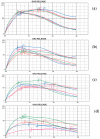Effects of Adding Legume Flours on the Rheological and Breadmaking Properties of Dough
- PMID: 34068906
- PMCID: PMC8156759
- DOI: 10.3390/foods10051087
Effects of Adding Legume Flours on the Rheological and Breadmaking Properties of Dough
Abstract
The influence of the addition of four legume flours, chickpea, broad bean, common bean and red lentil (in amounts of 5%, 10% and 15% to a wheat-rye composite flour (50:50:0-control flour), in ratios of 50:45:5; 50:40:10; 50:35:15) was studied by analyzing the rheological properties of dough in order to further exploit the functionality of legume flours in bakery products. The rheological properties of dough were monitored using a Mixolab 2. A Rheofermentometer F4 was used to check the dough fermentation, and a Volscan was used for evaluating the baking trials. The addition of different legume flours in the mixtures resulted in different viscoelastic properties of the dough. The results showed a weakening of the protein network depending on the amount of legume flour added and on the specific legume flour. On the contrary, all samples with a higher proportion of legume flour showed an increased resistance to starch retrogradation. All flours had the ability to produce a sufficient volume of fermenting gases, with the exception of flours with a higher addition of broad bean flour, and the baking test confirmed a lower bread volume for bread with this addition. The results of the sensory evaluation indicated that legume flour additions resulted in breads with an acceptable sensory quality, in the case of additions of 5% at the same level as the bread controls, or even better. The aromas and flavors of the added non-cereal ingredients improved the sensory profile of wheat-rye bread. Breads with additions of chickpea, common bean and broad bean had a considerable proportion of darker colors in comparison to the control bread and bread with red lentil.
Keywords: Mixolab; Rheofermentometer; baking test; broad bean flour; chickpea flour; common bean flour; dough rheology; gas retention; loaf volume; red lentil flour; sensory evaluation; wheat-rye flour.
Conflict of interest statement
The authors declare no conflict of interest. The funders had no role in the design of the study; in the collection, analyses, or interpretation of data; in the writing of the manuscript, or in the decision to publish the results.
Figures












Similar articles
-
Use of sourdough fermentation and mixture of wheat, chickpea, lentil and bean flours for enhancing the nutritional, texture and sensory characteristics of white bread.Int J Food Microbiol. 2014 Jun 16;180:78-87. doi: 10.1016/j.ijfoodmicro.2014.04.005. Epub 2014 Apr 13. Int J Food Microbiol. 2014. PMID: 24794619
-
Extracts with Nutritional Potential and Their Influence on the Rheological Properties of Dough and Quality Parameters of Bread.Foods. 2024 Jan 24;13(3):382. doi: 10.3390/foods13030382. Foods. 2024. PMID: 38338518 Free PMC article.
-
Assessment of Physicochemical Properties and Quality of the Breads Made from Organically Grown Wheat and Legumes.Foods. 2024 Apr 18;13(8):1244. doi: 10.3390/foods13081244. Foods. 2024. PMID: 38672916 Free PMC article.
-
Germinated/fermented legume flours as functional ingredients in wheat-based bread: A review.J Food Sci. 2025 Feb;90(2):e70022. doi: 10.1111/1750-3841.70022. J Food Sci. 2025. PMID: 39921303 Free PMC article. Review.
-
Implications of Blending Pulse and Wheat Flours on Rheology and Quality Characteristics of Baked Goods: A Review.Foods. 2022 Oct 20;11(20):3287. doi: 10.3390/foods11203287. Foods. 2022. PMID: 37431033 Free PMC article. Review.
Cited by
-
Pretreated Green Pea Flour as Wheat Flour Substitutes in Composite Bread Making.Foods. 2023 Jun 6;12(12):2284. doi: 10.3390/foods12122284. Foods. 2023. PMID: 37372495 Free PMC article.
-
Optimising White Wheat Bread Fortification with Vitamin D3 and Dietary Fibre: Balancing Nutritional Enhancement and Technological Quality.Foods. 2025 Jun 11;14(12):2055. doi: 10.3390/foods14122055. Foods. 2025. PMID: 40565664 Free PMC article.
-
Effect of Mealworm Powder Substitution on the Properties of High-Gluten Wheat Dough and Bread Based on Different Baking Methods.Foods. 2022 Dec 15;11(24):4057. doi: 10.3390/foods11244057. Foods. 2022. PMID: 36553798 Free PMC article.
-
Lupin (Lupinus spp.)-Fortified Bread: A Sustainable, Nutritionally, Functionally, and Technologically Valuable Solution for Bakery.Foods. 2022 Jul 12;11(14):2067. doi: 10.3390/foods11142067. Foods. 2022. PMID: 35885310 Free PMC article.
-
Optimization of the Processing Conditions for the Production of a Gluten-Free Bread from Sour Cassava Starch (Manihot esculenta) and Some Legumes (Arachis hypogaea, Vigna unguiculata, and Glycine max).Foods. 2023 Aug 24;12(17):3180. doi: 10.3390/foods12173180. Foods. 2023. PMID: 37685113 Free PMC article.
References
-
- Bread: A Nutrition Staple. EUFIC. [(accessed on 9 December 2014)]; Available online: https://www.eufic.org/en/healthy-living/article/bread-a-nutritious-stapl....
-
- Valavanidis A. Bread, Oldest Man-made Staple Food in Human Diet Bread Intake Is Integral to Good Health and Whole Grain Cereals Beneficial against Chronic Diseases. [(accessed on 15 November 2018)]; Available online: www.chem-tox-ecotox.org/ScientificReviews.
-
- Dewettinck K., Van Bockstaele F., Kühne B., Van de Walle D., Courtens T., Gellynck X. Nutritional value of bread: Influence of processing, food interaction and consumer perception. J. Cereal Sci. 2008;48:243–257. doi: 10.1016/j.jcs.2008.01.003. - DOI
-
- Sabanis D., Tzia C. Effect of Rice, Corn and Soy Flour Addition on Characteristics of Bread Produced from Different Wheat Cultivars. Food Bioprocess Technol. 2009;2:68–79. doi: 10.1007/s11947-007-0037-7. - DOI
-
- Ocieczek A., Kostek R. Sorptive properties of type 2000 wheat and rye flours. Acta Agrophys. 2009;14:393–402.
Grants and funding
LinkOut - more resources
Full Text Sources

